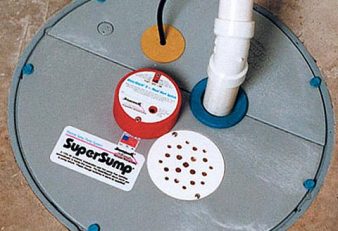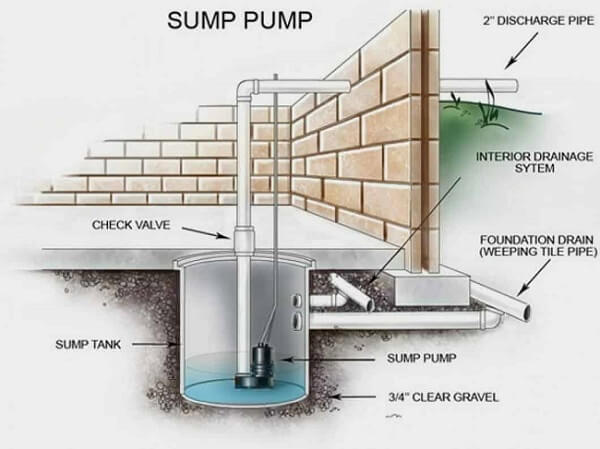Troubleshooting sump pump issues
As long as they have a back-up power source, sump pumps are fairly reliable. Nevertheless, here are some things to watch out for:
Debris in the pump
Sump pits can fill up with debris, especially open pits without a covering. If too much dirt or debris gets into the pump itself, the system will not operate properly, and may even shut down completely. If a debris-covered switch gets stuck in the ON position, the motor can burn out, potentially causing a fire.
Clogged or frozen discharge lines
Most sump pump systems have an air gap. The air gap is a section of the discharge pipe that’s open, to allow water to escape the system if the pipes freeze or clog. Normally, the air gap is located where the discharge pipe exits the building.
The air gap may not be literal gap; it may be a slotted pipe or have a vented cover, or one of many possible forms including atrium, candy cane, pipe-in-pipe, and others.
Depending on which type of air gap your sump pump uses, it may be susceptible to getting clogged. You should periodically inspect your air gap while the sump pump is running to ensure that water is flowing through it freely.
Wrong sized pump
If your pump’s flow rating is inadequate, it could struggle to displace all the water entering your home and burn out the motor.
Missing or broken check valve
Water that’s expelled from the sump pump usually travels 6-10 vertical feet to exit your house—quite a lot of work for a small pump. Any problems with your check valves will increase the back pressure on the pump, putting it under additional strain.
Improper connection to sewage line
Sewer systems are not designed to handle large volumes of runoff resulting from heavy rain or snowmelt. If your home’s sump pump is connected to the sewer, it could overload of the system, causing a water backup. This connection also provides an additional point of ingress for water. Consider consider disconnecting your pump from the sewer system (with input from a professional if you need to design a new outflow path).
Float switch stuck on
If your sump pump’s float switch is stuck on, the pump will run continuously when it doesn’t need to. A stuck float switch may simply be stuck. First, check the switch to see if there’s any debris jamming it. Clear the debris and see if it starts working properly.
Alternatively, float switches sometimes get stuck if the pump has wandered out of its original position. As they run, sump pumps vibrate, and may move themselves far enough that the float switch starts getting stuck on something. To fix this issue, reset and re-level your sump pump into the right position.
Not turning on
There are several possible reasons that your sump pump isn’t turning on:
- The float switch may be stuck in the off position. Try manually raising the float switch by hand to see if your pump turns on.
- Your pump may not be getting enough power. Ensure it’s plugged into a functioning power outlet (test the outlet with something else if you need to) and make sure it hasn’t blown a breaker. Sump pumps should have their own dedicated circuit.
- The pump motor could be overheated. If a pump has to operate continuously for too long, or it’s pumping more water than it’s designed for, it might overheat. If your sump pump often overheats, it may be too small.
- Your sump pump’s motor could have burnt out. If your sump pump won’t operate despite ample power and a functioning switch, you may need to replace the motor.
- The pump could be clogged. Check the pump’s discharge pipe (normally located outside at ground level) to ensure that water can flow smoothly. Then, unplug the pump and inspect the intake for blockage. You may need to remove the pump from the sump pit.
What will your home insurance provider want to know?
Water damage accounts for more home insurance claims than fire and theft combined. In fact, the average cost of a flooded basement insurance claim is $43,000. As such, it’s likely that your home insurance provider will want to know whether your home has a sump pump and a back-up power system.
If you live in an area that’s at risk of flooding, your home insurance provider may require a sump pump before they’re willing to provide coverage. Insurers often impose higher flood deductibles for homes in high-flood-risk areas as well.
Related articles
At Square One, we don’t necessarily require that your home have a sump pump. However, in higher-risk areas, customers with battery-backed-up sump pumps are eligible for lower premiums. To get a quote on your own home insurance, click the button at the bottom of this page.
Is sump pump failure covered by insurance?
If your sump pump fails and causes your home to suffer water damage, your home insurance will only cover the resulting water damage if it normally covers that type of loss. This depends on how the water gets into your home.
In one example, if your sump pump fails during a rainstorm, allowing groundwater to back up through the sump and into your basement, your home insurance would only cover the loss if it normally covers losses caused by the backing up of sewer, septic and sump systems. Most home insurance policies exclude this kind of loss by default, and would require the purchase of an optional Sewer Backup endorsement that includes sump pump backups.
In another example, if your sump pump were to fail during an overland flooding event – like a river that overflows its banks – many home insurance policies would not respond to this kind of damage at all, whether or not the sump pump is functioning properly.
Some home insurance providers offer overland flooding coverage as an optional endorsement. Square One includes overland flood coverage on most of the policies we sell.
Commonly asked questions
How do I know if I need a sump pump?
In any home that has a basement, or any part of the house located below-grade (that’s most buildings in Canada), a sump pump is never a bad idea. If your basement has ever flooded in the past, you absolutely need a sump pump. If you live in a flat or low-lying area, or somewhere that gets a lot of snow or rain, you should have a sump pump. If you discover moisture in your basement, dry it out with a dehumidifier and check back a few days later. If the moisture has returned, you probably need a sump pump.
Sump pumps are relatively inexpensive (especially compared to the cost of repairing water damage), so most homeowners with a basement should consider adding a sump pump if they don’t already have one.
How often should a sump pump run?
How often a sump pump runs depends on its local conditions. Some basements are closer to the water table than others, and so their sump pumps run more often. As well, your property’s grading might cause the sump pump to run even during light rain.
Following heavy periods of rain, it’s common for a sump pump to run intermittently for several days.
If you think your sump pump is running too often, or it suddenly started running more often than you’re used to, there may be something wrong. Here are some potential causes:
- A faulty check valve. The check valve lets water out, but not back in. If it’s malfunctioning, there may be water running back into the sump pit and causing the pump to work harder than normal. Check valves are usually installed near the pump, in the sump pit. Not every sump pump has a check valve installed.
- A blocked discharge line. If there’s debris in the outlet pipes, the pump will have to work harder to push water through.
- A pump that’s too small. If you can’t find any mechanical issues, but your pump is always working, it may simply be too small for your home. Run the calculations from further up the page to see if you need a more powerful pump.
- A change in the water table. Water tables can change over time, especially seasonally. If the water table at your home rises past the height of your sump pit, your pump will run much more often. The fix may not be simple (if indeed it requires a fix); you’ll probably need to find a sump pump professional to see what they suggest.
How does a battery backup work for a sump pump?
Having a battery backup sump pump is important. They work by automatically coming on as soon as the main pump stops working or can’t keep up with the rate of water inflow.
The backup isn’t just a battery connected to the main pump—it’s a totally separate pump. Though, you can buy combination sump pumps that have both a primary and a backup pump in the same unit.
Most models of backup pump will run occasionally just to check that they’re still functioning. If they aren’t, they’ll sound an alarm to let you know. If you find that your backup pump (or your main pump for that matter) isn’t working, fix the problem as soon as possible.
Want to learn more? Visit our Getting to Know Your Home resource centre for the complete rundown on all your home's systems and features. Or, get an online quote in under 5 minutes and find out how affordable personalized home insurance can be.



